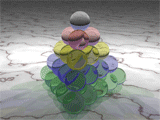Materials Science and Engineering/Doctoral review questions/Daily Discussion Topics/January 5, 2008
(111) and (100) planes
[edit | edit source]
The (111) plane is the lowest energy interface
(100) texture results from strain
- This plane is associated with the lowest Young modulus
If creating this interface by straining a material, apply thermal energy to allow the atoms to rearrange
Ohm's Law and Rectifying Behavior
[edit | edit source]
What causes deviation of ohmic behavior of a light bulb?
[edit | edit source]Increase in resistivity due to increase of temperature
Rectifying behavior of a junction
[edit | edit source]Change of conductivity due to impurity content
[edit | edit source]Scattering results from introduction of impurities into metal
Impurities in semiconductor can increase the number of charge carriers
What is the effect of electromigration?
[edit | edit source]Electromigration is the transport of material caused by the gradual movement of the ions in a conductor due to the momentum transfer between conducting electrons and diffusing metal atoms. The effect is important in applications where high direct current densities are used, such as in microelectronics and related structures. As the structure size in electronics such as integrated circuits (ICs) decreases, the practical significance of this effect increases.
Principles of statistical mechanics
[edit | edit source]Boltzmann's Law
[edit | edit source]Boltzmann's statistics provides a description of the spatial arrangement of molecules in a potential field (magnetic, electrical)
- up and down spins
Indistinguishable and Distinguishable Particles
[edit | edit source]- Indistinguishable particles: Boltzmann's statistics
- Distinguishable particles: Fermi-Dirac statistics
Heat Capacity
[edit | edit source]Contributions of each degree of freedom to energy
[edit | edit source]- per degree of freedom (per molecule)
- Vibrations
- per degree of freedom (per mole)
- when considering three dimensions
Total energy of a diatomic molecule
[edit | edit source]
- translational (x,y,z) freedom:
- vibrational freedom:
- rotational freedom:
Definition of heat capacity
[edit | edit source]Per mole:
Heat capacity in a metal
[edit | edit source]Five types of polarization
[edit | edit source]On application of an electric field, electron deviates from nucleus on a small time interval
In ionic materials, ions can move
Information Suggested to MEMORIZE
[edit | edit source]Mobilities of materials classes
[edit | edit source]- Metals ~ 10^8 S/m
- Semiconductors (doped) ~ 10^3
- Semiconductors (undoped) ~ 10^(-2)
- Holes in Si
- Electrons in Si
- Insulators ~ 10^(-14)
Young's Modulus of materials classes
[edit | edit source]- Metals ~ 100 GPa (10^11 Pa)
- Rubbers ~ 10 MPa (10^7 Pa)
Band gap of materials
[edit | edit source]- Si = 1.12 eV
- GaAs = 1.42 eV
- Ge = 0.7 eV
- Visible light = 1.77-3.10 eV
Structures of materials
[edit | edit source]- III-V compounds
- Wurtzite (combination HCP)
- Zinc blende (combination of FCC)
Density of State Derivations
[edit | edit source]High-k materials
[edit | edit source]- Why are high k-materials needed?
- Homeworks may be a helpful resource
- Fabrication of high k materials
Moore's Law
[edit | edit source]- Resource: paper by Megan and George
Most significant problems of the silicon industry
[edit | edit source]- Resistance of interconnects
- Channel mobility will be very good
Modern channel width
[edit | edit source]- 45 nm gate: channel length
- 7 nm oxide thickness
- Reduce tunneling effects
BJT
[edit | edit source]- Draw structure
- How to improve upon the device?
- Significance of heterojunctions
Examples of Major Material Classes
[edit | edit source]- Indirect semiconductor: Si
- Direct semiconductor: GaAs
- Ferroelectric: BaTiO3
- Superconductor: YBaCuO3, Nb-Ti
- Antiferromagnetic: Cr, Mn
- Soft ferromagnetic (refrigerator doors): defect-free Fe-Ni (permalloy)
- Hard ferromagnetic (refrigerator magnets): defect-full BaFeOx, rare-earth compounds, Alnico
- Anisotropic ferromagnets: Fe (BCC, [100] easy direction), Ni (FCC, [111]), Co (HCP, [0001])
- Diamagnetic: C2 (no net spin)
- Paramagnetic: B2 (net spin)
- Magnetoresistance:
- High-K Dielectric: HfO2
- Low-K dielectric:
- Polymer: Polyethylene
- Miscible system:
- Immiscible system:
List Of "Must Know" Trick Questions
[edit | edit source]- Write down Fick's first and second laws, as generally as possible. What is the origin of these equations?
- What happens to metals (such as Na) under extremely high pressures?
- Why does the electrical conductivity suddenly increase in metals at very low temperatures?
- What is k in Bloch's Theorem?
- What is so unique about diamond?
- Why is the sky blue? Why are sunsets red?
- What is the fundamental flaw in the regular solution model?
- Why do we use effective mass, rather than just mass, for mobility of electrons in a metal?
- What happens to the bandgap of a material under hydrostatic pressure?




![{\displaystyle E={\frac {1}{2}}k_{B}T[3+1+2]}](https://wikimedia.org/api/rest_v1/media/math/render/svg/26028cd7bbcfe2b65893ac3a73f958b5975d761e)



![{\displaystyle C_{v}={\frac {d}{dT}}[E=3k_{B}T]N_{A}}](https://wikimedia.org/api/rest_v1/media/math/render/svg/c85c0c046fac21590baac1b69d51bd3c068c16e9)




